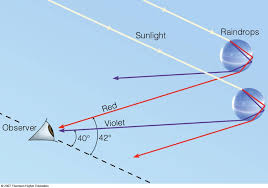Overview
Rainbows, glories, fogbows, and glassbows are all related phenomena caused by the nature of light. Each color is created by light hitting raindrops or beads of glass. They have fascinated people for millennia, including Aristotle and Sir Isaac Newton.
The Science of Rainbows
Rainbows are phenomena that are created whenever the conditions are right for them, according to physical laws of optics. The light source must be behind the observer, water droplets must be in the air in front of the observer, and there must be a 42 degree angle between the observer and the water droplets. The 42-degree angle produces the wavelength for red, and a 40-degree angle produces violet, but blue is the easiest to see for most. Light refracts through the water droplets as it enters, is bent into a spectrum of colors, reflects, and refracts again as it exits. Different droplets reflect the light at different angles, so some reflect red while others reflect the other colors. Although the eye separates the different colors into bands, colors are actually in a continuous gradation.
How Rainbows Are Made
Rainbows can be produced by any source of water droplets – raindrops, the arc of water from a garden hose, the mist from a waterfall, or spray from the wake of a water skier, speedboat, or pounding surf. They appear circular rather than straight because they are part of the circumference of a circle with the center on a line with the observer’s head, their shadow, and a point below the horizon called the antisolar point. Half the rainbow is below the horizon and invisible to the observer. The size of the rainbow depends on the amount of raindrops producing it.
Types of Rainbows
Most rainbows consist of a primary rainbow, with red at the outside and violet on the inside, and a secondary rainbow, with the colors reversed so that violet is on the outside and red is on the inside. This is because the light is reflected twice by some raindrops. The secondary rainbow appears outside the primary rainbow and is much fainter, because it is produced by fewer raindrops. The area between the primary and secondary rainbows appears darker than the rest of the sky, because of the way light is reflected from raindrops at a greater angle than 42 degrees.
A Circular Glory
Circular rainbows can be seen if the observer is in an airplane or at a high enough elevation that they can see the entire circle. Some observers consider the circular rainbow that can be seen from an airplane window as a glory. In that case, the plane is flying low enough above cloud cover that its shadow is visible. It can also be observed from high mountain peaks, and the ancient Chinese believed that a glory around someone’s head in shadow was a sign of enlightenment.
Bows Made from Fog
Rainbows that appear from fog, such as the bows that are created by car headlights, appear white rather than brightly-colored. That is because the droplets that make up fog are smaller than colored wavelengths. Sometimes faint reddish or bluish colors can be seen.
Making a Glassbow
Rainbows can also be made by refraction and reflection from tiny transparent glass beads, such as those used in sandblasting or art projects. The transparent spherical beads take the place of raindrops, and are glued close together on a piece of black poster board 12 inches square. It is best to use a spray adhesive to adhere the beads to the poster board or black foam core board, and work outside to avoid the fumes and most of the mess. Students can then use strong sunlight outside or a spotlight inside to cast the bow from the transparent beads.
Interested in science tutoring services? Learn more about how we are assisting thousands of students each academic year.
SchoolTutoring Academy is the premier educational services company for K-12 and college students. We offer tutoring programs for students in K-12, AP classes, and college. To learn more about how we help parents and students in Muncie, IN: visit Tutoring in Muncie, IN





